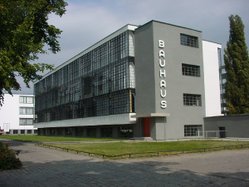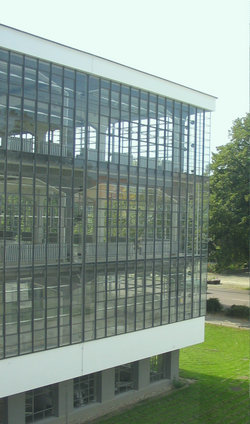ARCHITECTURAL REVIEW

05 August, 2006
Bauhaus 1919-33
The Bauhaus art school existed in three different cities (Weimar from 1919 to 1925, Dessau from 1925 to 1932, and Berlin from 1932 to 1933), under three different architect-directors (Walter Gropius from 1919 to 1928, Hannes Meyer from 1928 to 1930, and Ludwig Mies van der Rohe from 1930 to 1933).
The Bauhaus art school existed in three different cities (Weimar from 1919 to 1925, Dessau from 1925 to 1932, and Berlin from 1932 to 1933), under three different architect-directors (Walter Gropius from 1919 to 1928, Hannes Meyer from 1928 to 1930, and Ludwig Mies van der Rohe from 1930 to 1933). These changes of venue and leadership meant a constant shifting of focus, technique, instructors, and politics. When the school moved from Weimar to Dessau, for instance, the pottery shop was discontinued, although it had been an important revenue source. When Mies took over the school in 1930, he transformed it into a private school, and would not allow any supporters of Hannes Meyer to attend.
The school was founded by Gropius at the conservative city of Weimar in 1919, as a merger of the Weimar School of Arts and Crafts (Grossherzogliche Kunstgewerbeschule) and the Weimar Academy of Fine Arts (Grossherzogliche Hochschule für Bildende Kunst).
Most of the contents of the workshops had been sold off during World War I. The early intention was for the Bauhaus to be a combined architecture school, crafts school, and academy of the arts. Much internal and external conflict followed.
Gropius argued that a new period of history had begun with the end of the war. He wanted to create a new architectural style to reflect this new era. His style in architecture and consumer goods was to be functional, cheap, and consistent with mass production. To these ends, Gropius wanted to reunite art and craft to arrive at high-end functional products with artistic pretensions. The Bauhaus issued a magazine called "Bauhaus" and a series of books called "Bauhausbücher". Its head of printing and design was Herbert Bayer.
The Bauhaus was largely subsidized by the early Weimar Republic. After a change in local government, the school moved to Dessau in 1925, where the civic atmosphere was more industrial and progressive. After the Bauhaus moved to Dessau, a school of industrial design with teachers and staff less antagonistic to the conservative political regime remained in Weimar. This school was eventually known as the Technical University of Architecture and Civil Engineering and in 1996 changed its name to Bauhaus University Weimar. In 1927, the Bauhaus style and its most famous architects heavily influenced the exhibition "Die Wohnung" ("The Dwelling") organized by the Deutscher Werkbund in Stuttgart. A major component of that exhibition was the Weissenhof Siedlung, a settlement or housing project.
|
|
|
- Bauhaus - Dessau |
Gropius was succeeded by Meyer, and then in turn by Mies. Under increasing political pressure the Bauhaus was closed on the orders of the Nazi regime in 1933. The Nazi Party and other fascist political groups had opposed the Bauhaus throughout the 1920s. They considered it a front for communists, especially because many Russian artists were involved with it. Consequently, many Weissenhof architects fled to the Soviet Union, thus strengthening the effect. Nazi writers such as Wilhelm Frick and Alfred Rosenberg called the Bauhaus "un-German," and criticized its modernist styles.
The paradox of the early Bauhaus was that, although its manifesto proclaimed that the ultimate aim of all creative activity was building, the school wouldn't offer classes in architecture until 1927. The single most profitable tangible product of the Bauhaus was its wallpaper.
|
|
|
Bauhaus - Berlin |
During the years under Gropius (1919–1927), he and his partner Adolf Meyer observed no real distinction between the output of his architectural office and the school. So the built output of Bauhaus architecture in these years is the output of Gropius: the Sommerfeld house in Berlin, the Otte house in Berlin, the Auerbach house in Jena, and the competition design for the Chicago Tribune Tower, which brought the school much attention. The definitive 1926 Bauhaus building in Dessau is also attributed to Gropius. Student work amounted mainly to unbuilt projects, interior finishes, and craft work like cabinets, chairs and pottery.
In the two years under the outspoken Swiss Communist architect Hannes Meyer, the architectural focus shifted away from aesthetics and towards user requirements. But there were major commissions: one by the city of Dessau for five tightly designed "Laubenganghäuser" (apartment buildings with balcony access), which are still in use today, and another for the headquarters of the Federal School of the German Trade Unions (ADGB) in Bernau bei Berlin. Meyer's approach was to research users' needs and scientifically develop the design solution.
And then Mies van der Rohe repudiated Meyer's politics, his supporters, and his architectural approach. As opposed to Gropius' "study of essentials", and Meyer's research into user requirements, Mies advocated a "spatial implementation of intellectual decisions", which effectively meant an adoption of his own aesthetics. Neither Mies nor his Bauhaus students saw any projects built during the 1930s.
The popular conception of the Bauhaus as the source of extensive Weimar-era working housing is not accurate. One single project, the apartment building project in Dessau, falls in that category, and it's fair to say that developing worker housing was not the first priority of Gropius nor Mies. It was the Bauhaus contemporaries Bruno Taut, Hans Poelzig and particularly Ernst May, as the city architects of Berlin, Dresden and Frankfurt respectively, who are rightfully credited with the thousands of socially progressive housing units built in Weimar Germany.
|
|
|
Walter Gropius in front of his competition entry for the Chicago Tribune Tower 1922, taken in 1928 |
The Bauhaus had a major impact on art and architecture trends in Western Europe, the United States and Tel Aviv in the decades following its demise, as many of the artists involved fled or were exiled by the Nazi regime.
Gropius, Breuer, and Moholy-Nagy re-assembled in England during the mid 1930s to live and work in the Isokon project before the war caught up to them. In the late 1930s Mies van der Rohe re-settled in Chicago and became one of the pre-eminent architects in the world.
Moholy-Nagy also went to Chicago and founded the New Bauhaus school under the sponsorship of industrialist and philanthropist Walter Paepcke. Herbert Bayer, also sponsored by Paepcke, moved to Aspen, Colorado in support of Paepcke's Aspen projects.
Both Gropius and Breuer went to teach at the Harvard Graduate School of Design and worked together before their professional split in 1941. The Harvard School was enormously influential in the late 1940s and early 1950s, producing such students as Philip Johnson, I.M. Pei, Lawrence Halprin and Paul Rudolph, among many others.
One of the main objectives of the Bauhaus was to unify art, craft, and technology. The machine was considered a positive element, and therefore industrial and product design were important components. Vorkurs ("initial course") was taught; this is the modern day Basic Design course that has become one of the key foundational courses offered in architectural schools across the globe. There was no teaching of history in the school because everything was supposed to be designed and created according to first principles rather than by following precedent.
One of the most important contributions of the Bauhaus is in the field of furniture design. The world famous and ubiquitous Cantilever chair by Dutch designer Mart Stam, using the tensile properties of steel, and the Wassily Chair designed by Marcel Breuer are two examples.
The physical plant at Dessau survived the War and was operated as a design school with some architectural facilities by the Communist German Democratic Republic. This included live stage productions in the Bauhaus theater under the name of Bauhausbühne ("Bauhaus Stage"). After German reunification, a reorganized school continued in the same building, with no essential continuity with the Bauhaus under Gropius in the early 1920s [1].
In 1999 Bauhaus-Dessau College started to organize postgraduate programs with participants from all over the world. This effort has been supported by the Bauhaus-Dessau Foundation which was founded in 1994 as a public institution.
American art schools have also rediscovered the Bauhaus school. The Master Craftsman Program at Florida State University bases its artistic philosophy on Bauhaus theory and practice.
Many outstanding artists of their time were lecturers at Bauhaus:
Josef Albers
Marianne Brandt
Marcel Breuer
Lyonel Feininger
Ludwig Hilberseimer
Johannes Itten
Βασίλι Καντίνσκυ (Wassily Kandinsky)
Πωλ Κλέε (Paul Klee)
Gerhard Marcks
László Moholy-Nagy
Georg Muche
Hinnerk Scheper
Oskar Schlemmer
Joost Schmidt
Lothar Schreyer
Gunda Stölzl
Links:
Bauhaus-archiv in Berlin
Foundation bauhaus dessau
|
|
|
Bauhaus - 1993 |














